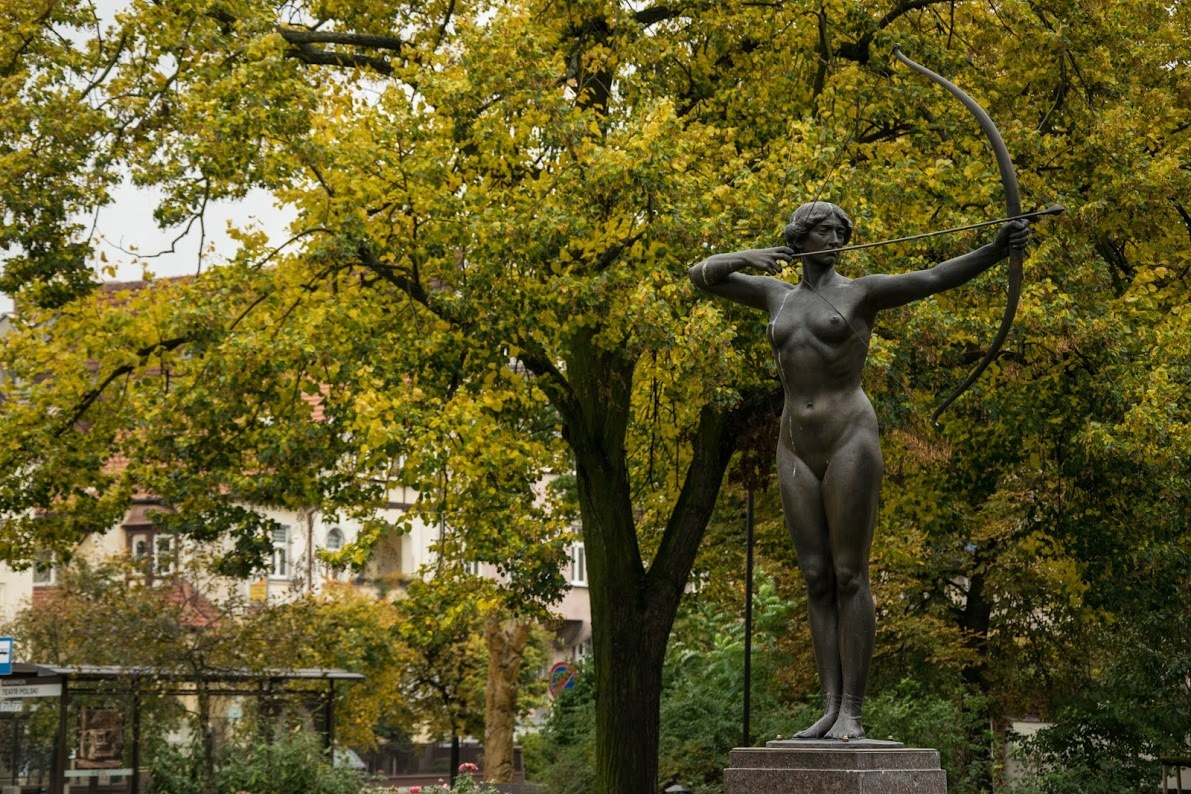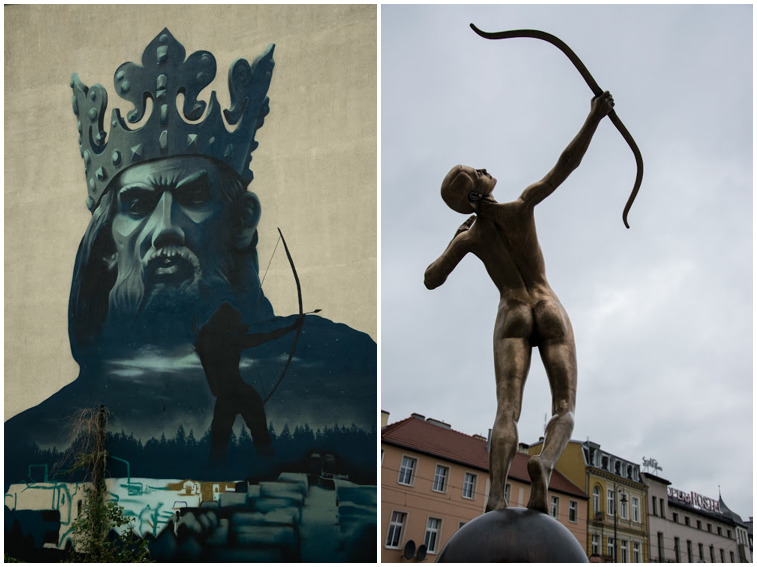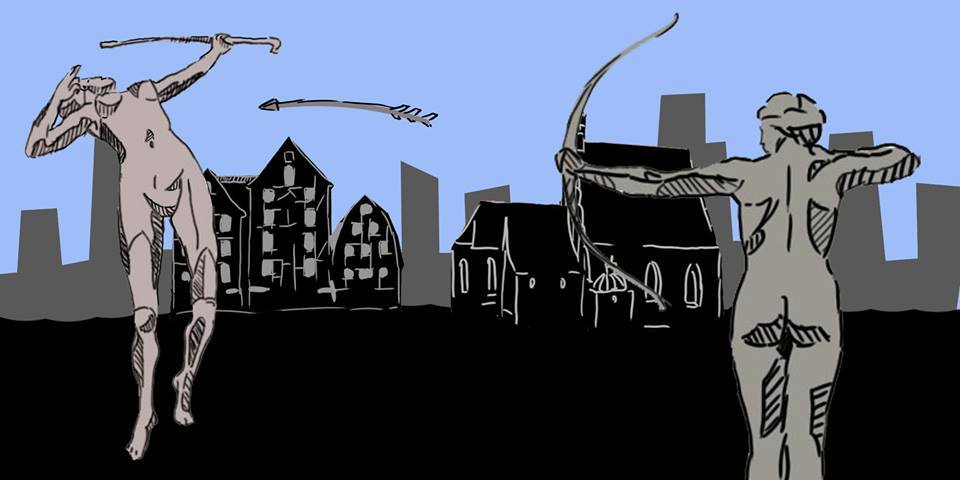
 |
POLISH DESCRIPTION
|
Podczas nieco ponad 100-letniej bytności w naszym mieście Łuczniczka zyskała rangę jednego z głównych symboli Bydgoszczy. Droga, którą przebyła nasza Basia (tak, tak, Łuczniczka ma imię – właśnie Basią nazwali ją bydgoszczanie kilkadziesiąt lat temu w plebiscycie „Dziennika Wieczornego”) nie należała jednak do łatwych. Ale po kolei.
Łuczniczka nie jest rodowitą bydgoszczanką. Narodziła się w roku 1908 w berlińskiej pracowni popularnego wówczas nie tylko w Niemczech rzeźbiarza Ferdynanda Lepckego. Ok. metrową kopię dzieła artysta zaprezentował w wielu miastach Europy, w tym także w Bydgoszczy na wystawie Niemieckiego Towarzystwa Sztuki i Wiedzy, podczas której rzeźba wzbudziła szczególny zachwyt miejscowych władz i przedsiębiorców. Lepcke był znany bydgoszczanom – to on w 1904 r. stworzył Fontannę Potop, najbardziej wówczas reprezentacyjną rzeźbę Śródmieścia. Niewykluczone, że właśnie znajomość rzeźbiarza z burmistrzem Bydgoszczy Hugo Wolffem zadecydowała o sprowadzeniu Łuczniczki do naszego miasta, choć zakupiona została już nie od autora, lecz od jego brata. Lepcke zmarł bowiem w 1909 roku na zapalenie płuc w wieku zaledwie 43 lat.
Zakup rzeźby sfinansował Louis Aronsohn - bydgoski bankier i społecznik żydowskiego pochodzenia. Uroczyste odsłonięcie posągu miało miejsce 18 października 1910 r., w dniu 60-tych urodzin fundatora. Łuczniczka stanęła na ówczesnym placu Teatralnym. Zwrócona w stronę ul. Mostowej, strzałą celowała w gmach Teatru Miejskiego, dziś niestety już nieistniejącego.
Jak nierzadko bywa w przypadku dzieł sztuki, Łuczniczka budziła skrajne emocje. Podczas gdy jedni zachwycali się jej piękną atletyczną, a zarazem kobiecą sylwetką, inni uważali ją za kicz, niegodzien prestiżowego miejsca w centrum miasta. Bardziej pruderyjnych mieszkańców (czy raczej mieszkanki) Bydgoszczy szczególnie raziła obecność posągu na trasie konduktów żałobnych czy procesji Bożego Ciała, które prowadziły z bydgoskiej Fary do kościoła Klarysek. Bywało, że na czas uroczystości religijnych naszą nagą bohaterkę przysłaniano prześcieradłami czy specjalnymi tekturowymi ekranami. Jedną z zagorzałych przeciwniczek Łuczniczki, postulujących jej zniszczenie, była Pola Negri, do której w latach 20-tych XX w. należała kamienica vis a vis Teatru Miejskiego.
Dyskusje na temat kontrowersyjnego dzieła trwały latami. Pomysły były różne – przyprawić Łuczniczce listek figowy, przenieść ją na obrzeża miasta, przetopić na posąg Aleksandra Fredry, zatopić w Brdzie. Mało brakowało, by wylądowała ona u naszych przyjaciół z GeoPyry – z ofertą kupna zwrócił się do bydgoskich radnych prezydent Poznania Cyryl Ratajski. Na szczęście jednak bydgoszczanie się opamiętali i do transakcji nie doszło. Skończyło się jedynie na kilkukrotnych przenosinach rzeźby, ostatecznie do parku Kochanowskiego. W pewnym sensie historia zatoczyła koło – Łuczniczka znowu strzeże teatru.
Zmieniły się czasy i obyczaje. Dziś posąg nagiej sportsmenki nikogo nie bulwersuje, bydgoszczanie się nią chlubią. Patronuje drużynom sportowym, jej imieniem nazwano miejską halę widowiskowo-sportową. Postać Łuczniczki można zobaczyć chyba w każdym folderze reklamującym nasze miasto, a jej statuetka jest nagrodą w wielu prestiżowych bydgoskich konkursach.
JAK ZALOGOWAĆ KESZA?
Sfotografuj się z Łuczniczką w tle w jednym z trzech miejsc:
- w parku Kochanowskiego – z oryginalną rzeźbą F.Lepckego,
- przed Operą Nova (Waypoint 1) – z Łuczniczką Nova, artystyczną wariacją na temat oryginalnej Basi, stworzoną przez Macieja Jagodzińskiego-Jagenmeera z okazji 667 urodzin Bydgoszczy,
- przy ul. Jagiellońskiej 36 (Waypoint 2) – przed muralem z królem Kazimierzem Wielkim i Łuczniczką
najlepiej stając w pozycji Łuczniczki :-) a swoje zdjęcie zamieść w logu.
Jeśli z jakiegoś powodu nie możesz lub nie chcesz załączyć takiej fotografii, zastąp ją zdjęciem swojego GPS.

 |
ENGLISH DESCRIPTION
|
For over 100 years spent in our city the Archer Lady has become one of the main symbols of Bydgoszcz. The way our Barbara has gone (yes, the Archer Lady has got the name – she was called Barbara several decades ago in the plebiscite of the "Evening Diary") has not been easy though. But first things first.
The Archer does not originate from Bydgoszcz. She was created in 1908 in Berlin by Ferdinand Lepcke, a sculptor famous in Germany as well as in other European countries. He presented the copy of his work in many cities all over the Europe, including Bydgoszcz at the exhibition of the German Society of Arts and Knowledge, where the sculpture aroused the special admiration of local authorities and entrepreneurs. Lepcke was known to the inhabitants of Bydgoszcz – it was him who’d created the Fountain of the Deluge in 1904, the most representative sculpture of the city. It is possible that the knowledge of the sculptor with the mayor of Bydgoszcz Hugo Wolff decided to bring the Archer to our city, although it was purchased not from the author, but from his brother. Lepcke died of pneumonia at the age of 43 in 1909.
The purchase of the sculpture was funded by Louis Aronsohn, a Bydgoszcz banker, councilor and social worker of the Jewish origin. The unveiling of the statue took place on October 18, 1910, on the 60th birthday of the founder. The Archer Lady was then placed at the Theater Square. Facing towards Mostowa street, she aimed the arrow at the Municipal Theater, unfortunately no longer existing today.
As it often happens in the case of works of art, the Archer Lady awoke extreme emotions. While some were delighted by her athletic and feminine silhouette, others regarded her not good enough for a prestigious place in the city center. The more prudish inhabitants of Bydgoszcz (mostly female) were specially disgusted by the presence of the statue on the way of funeral or Corpus Christi processions, which led from the Bydgoszcz Cathedral to the Order of the Poor. It happened that during some Christian events our naked heroine was covered with sheets or special cardboard screens. One of the fierce opponents of the Archer, demanding its destruction, was the famous actress Pola Negri, who in the 1920s owned the tenement vis a vis the City Theater.
Discussions about the controversial work lasted for years. The ideas were different - give the Archer a fig leaf, move it to the suburbs, melt down, sink in the Brda river. It almost happened she moved to our friends from GeoPyra – Mr. Cyryl Ratajski, the mayor of Poznań city once came to Bydgoszcz with the offer to buy the statue. Luckily, however, the Bydgoszcz city councilor resigned and the transaction has not been made. It ended only with a few moves of the sculpture, eventually to Kochanowski Park, where the Archer again guarded the theater.
Times and customs have changed. Today, the statue of a naked sportswoman no longer makes anyone upset and Bydgoszcz citizens are proud of her. The Archer patronizes the sports teams, the city sport and entertainment hall is called with her name. The Archer Lady can be seen in every folder advertising our city, and its statue is a prize in many prestigious Bydgoszcz contests.
HOW TO LOG THE VIRTUAL?
Take a picture of yourself and the Archer in one of below places:
- Kochanowski Park – withe the original sculpture by F.Lepcke,
- in front of the Nova Opera (Waypoint 1) – with the Nova Archer, an artistic variation on the original Barbara, created by Maciej Jagodziński-Jagenmeer on the occasion of the 667 birthday of Bydgoszcz,
- at Jagiellońska street, No. 36 (Waypoint 2) – in front of the mural with King Casimir the Great and the Archer Lady
preferably standing in the position of the Archer :-) and put your photo in the log.
If for some reason you cannot or don’t want to include such a picture, replace it with a photo of your GPS.

Łuczniczka – graphics by Marta Walasek
 |
GERMAN DESCRIPTION
|
In etwas mehr als 100 Jahren der Existenz in unserer Stadt hat sich „Łuczniczka“ zu einem der Hauptsymbole von Bydgoszcz entwickelt. Der Weg, den unsere Basia durchgegangen ist (ja, ja, die Bogenschützin einen Namen hat - es wurde in der Umfrage „Official Evening“ vor Jahrzehnten als Basia genannt), war jedoch nicht einfach. Aber wiederum.
Die Bogenschützin ist nicht gebürtig in Bydgoszcz. Geboren 1908 im Berliner Atelier von dem Bildhauer Ferdinand Lepcke, der nicht nur in Deutschland sehr beliebt war. Ca. Meter Kopie des Kunstwerkes hat der Künstler in vielen europäischen Städten vorgestellt, auch bei der Ausstellung der Deutschen Gesellschaft der Kunst und Wissenschaft in Bydgoszcz, während der die Skulptur besondere Bewunderung der lokalen Behörden und Unternehmer angezogen hat. Lepcke war den Bürger von Bydgoszcz sehr gut bekannt. Im Jahre 1904 hat er einen Springbrunnen geschaffen, die repräsentativsten Skulptur der Innenstadt. Es ist nicht ausgeschlossen, dass die Bekanntschaft des Künstlers mit dem Bürgermeister von Bydgoszcz Hugo Wolff der Grund für den Kauf der Skulptur „Łuczniczka“ war. Sie wurde aber nicht direkt von dem Künstler sondern von seinem Bruder gekauft, weil Ferdinad Lepcke im Alter von 43 Jahre gestorben war.
Der Kauf der Skulptur wurde von Louis Aronsohn, einen Bankier und jüdischen ehrenamtlichen Täter finanziert. Die Enthüllung der Statue fand am 18. Oktober 1910 am 60. Geburtstag des Stifters statt. „Łuczniczka“ stand am damaligen Theaterplatz. Der Pfeil der Skulptur war auf das Stadttheater ausgerichtet, das heute existiert leider nicht mehr.
Wie es bei Kunstwerken oft der Fall ist, weckte die Bogenschützin extreme Emotionen. Während einige sich über ihre athletische und weibliche Silhouette freuten, sahen andere sie als Kitsch und nicht als repräsentativen Ort im Stadtzentrum. Für mehr prüde Einwohner (oder besser gesagt, Einwohnerinnen) von Bydgoszcz störte vor allem die Anwesenheit der Statue auf der Strecke der Trauerzügen oder Prozessionen, die von der Pfarrkirche zu Klaryski Kirche führten. Es gab Zeiten, in denen unsere religiöse Heldin mit Laken oder speziellen Pappschirmen abgeschirmt wurde. Einer der treuesten Gegner der Bogenschützin, die für die Zerstörung der Skulptur aufrief, war Pola Negri, der in den 20. Jahren des 20. Jahrhunderts das Mietshaus vis-a-vis des polnischen Theater gehörte.
Diskussionen über das kontroverse Kunstwerk dauerten jahrelang an. Die Ideen waren verschieden - der Bogenschützin ein Feigenblatt zu geben, sie zum Rand der Stadt zu verschieben, sie zum Skulptur von Aleksander Fredro zu schmelzen, sie in Brda Fluss zu versenken. Beinahe, hätte sie bei unseren Freunden aus „GeoPyra“ gelandet - mit dem Angebot an den Bydgoszcz Stadtrat hat sich der Bürgermeister von Poznań Cyryl Ratajski gewendet. Zum Glück waren die Burger von Bydgoszcz zu Vernunft gekommen und es sind keine Transaktionen stattgefunden. Es endete nur mit ein paar Umzügen der Skulptur, schließlich landete sie in Kochanowski Park. In gewissem Sinne rollte die Geschichte herum – die Bogenschützin bewachte erneut das Theater. Die Zeiten und Bräuchen haben sich verändert.
Heute ist die Statue einer nackten Sportlerin niemand aufgeregt, Alle sind stolz auf sie. Es fördert die Sportmannschaften, mit dem Namen „Łuczniczka“ wird die Sporthalle genannt. Die Bogenschützin kann in jedem Prospekt gesehen werden, der unsere Stadt werbt, und seine Statue ist ein Preis in vielen prestigeträchtigen Bydgoszcz-Wettbewerben.
NUN EURE AUFGABE:
Fotografieren Sie sich mit der Bogenschützin im Hintergrund an einem von drei Orten:
- im Kochanowski Park - mit der Originalskulptur von F. Lepcke,
- vor der Nova Opera (Wegpunkt 1) - mit Łuczniczka Nova, einer künstlerischen Variation der ursprünglichen Basia, von Maciej Jagodziński- Jagenmeer, der sie anlässlich des 667. Geburtstages von Bydgoszcz geschaffen hat,
- in der Jagielońska Strasse 36 (Wegpunkt 2) - vor dem Wandgemälde mit König Kasimir der Große und dem Bogenschützen
Am besten stehend in der Position wie die Bogenschützin :-) und dann Dein Foto im Logbuch platzieren.
Wenn Sie aus irgendeinem Grund kein solches Foto aufnehmen können oder möchten, ersetzen Sie es durch ein Foto Ihres GPS.
Virtual Reward - 2017/2018
This Virtual Cache is part of a limited release of Virtuals created between August 24, 2017 and August 24, 2018. Only 4,000 cache owners were given the opportunity to hide a Virtual Cache. Learn more about Virtual Rewards on the Geocaching Blog.